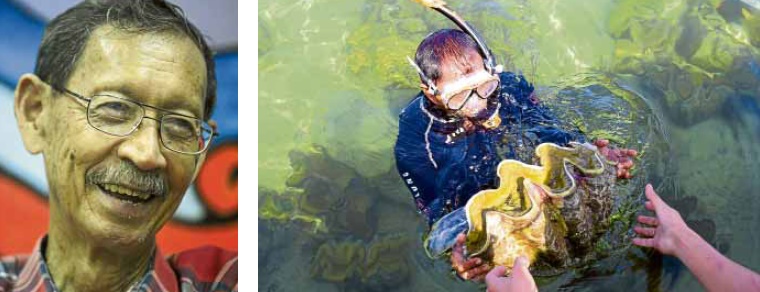
LEGACY Residents of Bolinao credit the late National Scientist Edgardo Gomez (left) for putting this coastal town in Pangasinan province on the world’s marine conservation and tourism maps through his work at the University of the Philippines Marine Science Institute. —PHOTOS BY NIÑO JESUS ORBETA AND WILLIE LOMIBAO
DAGUPAN CITY—HE may be gone but a legacy of National Scientist Edgardo Gomez in the once sleepy coastal town of Bolinao in Pangasinan province, will transcend generations.
It was in 1985 when Gomez, the founding director of the University of the Philippines Marine Science Institute (UPMSI), put up the UPMSI-Bolinao Marine Laboratory on Silaki Island in Bolinao for clam research programs and conservation.
The laboratory maintains a hatchery for giant clams (Tridacna gigas), locally known as “taklobo,” that began to breed clams from Solomon Island more than three decades ago.
Gomez’s initiative was a success and even earned for Bolinao the moniker “Giant Clams Capital of the Philippines,” former Mayor Jesus Celeste said.
Before his death on Sunday at 81, Gomez’s taklobo project has already cultured 35,000 adult and 11,000 juvenile giant clams, saving these from impending extinction.
“It was because of Dr. Gomez that Bolinao was opened to the scientific world, and it was because of him that the community learned about the importance of the marine environment to their lives,” environmental activist Margaret Celeste told the Inquirer on Wednesday.
Fight vs cement plant
Celeste and other residents of Bolinao are crediting Gomez not only for bringing back the giant clam population in the country but also for helping local tourism grow.
“First, it was the local and international scientists who came here [in Bolinao]. They may have informed others of the town’s beauty, encouraging more tourists to pay a visit. So the town earned a spot in tourism because of him (Gomez),” Margaret said.
The UPMSI, through Gomez, quietly supported the protracted war against an international consortium of companies that wanted to establish a cement plant in the town in the 1990s.
The UPMSI issued science-based statements on how the multimillion dollar cement plant would have torn apart the town’s pristine land and marine environment.
“Because of the support of the UPMSI, that help from different national and international organizations poured into the town. We owe it to Gomez’s leadership that Bolinao reached the environmental consciousness it has now,” the former mayor said.
The town is the source of giant clams reseeded in over 50 reefs in different coastal provinces, securing its survival for at least a generation, according to World Wide Fund for Nature-Philippines.
Coral reef regeneration
It was also Gomez who started the coral reef regeneration projects in the town and other areas.
Ronaldi Torres, president of Bolinao Business Tourism Association, said it was from Gomez that they learned how tourism was tied with the environment.
“He told us, ‘Without environment, there is no tourism,’ and now that is the mantra that we live by. Business, without considering the environment, is bound to fail, so we take care of our environment, which is the core of the town’s tourism programs and projects,” Torres said.
But what most residents remember is the way Gomez mingled with them.
“He was an internationally acclaimed scientist but he never showed he was superior even to the marginal fishermen. He was an intellectual person but he was very humble and knew how to deal with everyone. He listened to what everyone had to say. And he was always smiling,” Torres said.
‘People person’
“He was a people person,” he added.
At the UPMSI, Gomez’s colleagues described him as “a visionary academic leader, a great mentor and an honest and dedicated public servant.”
According to the National Academy of Science and Technology, Gomez was a known researcher, scientist, conservation advocate, and mentor in invertebrate biology and ecology, giant clam culture and restoration, and coral reef assessment and conservation.
Gomez was also recognized for his outstanding contributions and researches on marine ecosystems, which became the bases for management of and the conservation programs for the country’s marine resources.